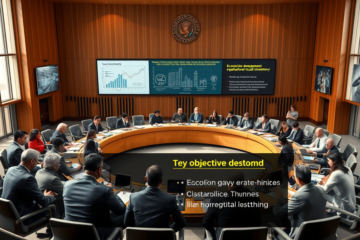Artificial Intelligence Startup Bubble
AI Startups are on the rise, but this appreciation may be creating the biggest and most dangerous bubble in history.
In this article, we'll explore comparisons between the current AI startup bubble and the '.com' bubble of the 1990s. We'll discuss the staggering market valuations of these companies, the misallocation of capital, and questions about the sustainability of this sector.
In addition, we will analyze the economic impact of a possible bursting of this bubble and the future implications of an eventual superintelligence in society.
The AI Bubble in Historical Perspective
A appreciation current AI startup scene is impressive, but it brings to mind the history from the .com company bubble of the 90s.
A economic bubble refers to a phenomenon where the market value of a specific asset or sector inflates rapidly, driven by excessive speculation, only to later undergo a sharp correction.
In the case of '.com' companies, over-enthusiasm for the internet led to a surge in stock prices, followed by a severe collapse.
Similarly, AI startups, many of them still unprofitable, have accumulated an exorbitant market value, close to US$ 1 trillion, suggesting a possible danger.
Us 90s, '.com' companies attracted large investments without a sustainable business model, reflecting today in AI companies that, even without robust profits, become targets of intense capital.
O current debate focuses on the sustainability of the sector, with uncertainty regarding the development of a superintelligence that can truly transform society.
If the AI bubble bursts, like the '.com' one, there could be a significant impact on Future GDP, and many technology initiatives may struggle to remain financially viable, resulting in products that do not generate the expected return.
Market Assessment and Capital Allocation
The AI startup market is currently valued at almost US$ 1 trillion, an impressive 17 times more than the famous bubble .with of the 1990s and four times more than the real estate crisis of 2008. This gigantic increase in value generates growing concern about the inadequate capital allocation, as many of these startups do not yet generate significant profits.
Below, a comparison of market values:
| Period | Market value |
|---|---|
| IA | US$ 1 tri |
| .with | US$ 60 billion |
| 2008 | US$ 250 billion |
.
The situation is made worse when we observe that, while companies like Nvidia manage to make profits, many sectors still operate with large deficits.
Investors are alert for a possible bursting of the bubble, which could negatively impact future economic growth.
The AI software sector, for example, is already beginning to see a reduction in investment volume.
Economic Sustainability of the AI Ecosystem
In the current scenario of artificial intelligence, we observe a striking mismatch between Nvidia and other companies in the sector.
While the Nvidia leverages substantial profits, with a profit margin of 769% in the last quarter, many AI startups face major financial challenges.
These startups accumulate billions in market value, but operate at significant losses.
As quoted by an expert analyst: “the sector grows on fragile foundations”, highlighting the inherent risk of a bubble hanging over the technology market.
Furthermore, while investment in AI software is beginning to decline, expectations for the development of a 'superintelligence' remain distant.
A excessive dependence from the Nvidia as market leader reflects the imbalance in the allocation of capital between profitable companies and those that have not yet demonstrated economic viability.
The sector's sustainability requires a reassessment of investment strategies, seeking a healthier balance between innovation and profitability.
Therefore, the impact of possible slowdown of AI startups in global Gross Domestic Product highlights the importance of more sustainable development, avoiding a repeat of past crises, such as the “.com” and the 2008 real estate crisis.
Fall in Investments in AI Software
The recent reduction in investment in AI software highlights a growing concern about the long-term economic viability of the sector.
This movement, driven by a perception of an economic bubble, could seriously threaten growth and innovation.
Studies show that AI adoption is on the rise, but the unbridled enthusiasm has led to inflated startup valuations, creating a risky environment for investors.
With the retraction in the flow of capital, critical challenges arise:
- Lower liquidity
- Revised revenue projections
- R&D Cut
These factors, combined with the expectation of lower-than-expected returns, can lead companies to review their strategies, significantly impacting the market and the economy.
A The sustainability of this market depends on the ability of startups to transform promises into profitable and scalable products, in a scenario where only giants like Nvidia remain profitable.
Stay tuned to the forecasts for business for 2025, as few companies will dominate the market, requiring a constant review of investment practices.
Macroeconomic Impacts of a Possible Burst
The macroeconomic impacts of a potential bursting of the artificial intelligence bubble could be significant and far-reaching across various economic spheres.
Firstly, the Gross Domestic Product (GDP) may suffer a substantial drop, as the technology sector has been one of the drivers of recent growth.
The meteoric rise in value of AI startups, which have accumulated almost US$ 1 trillion in market value, as highlighted by sources such as G1, represents a disproportionate allocation of capital, which, if it collapses, could have negative repercussions throughout the global economic fabric.
Furthermore, job volatility in the sector could increase dramatically.
The job market, which currently attracts professionals from diverse fields to AI technology, could become hostile terrain with rising unemployment rates.
Entire sectors of AI software may cease operations or halt hiring, as discussed in articles from CNN Brazil.
This hiring pullback would further increase the challenges for a global economy already recovering slowly from past crises.
Finally, production and investment in AI products without economic returns may proliferate, wasting resources on projects without sustainable viability.
The famous '.com' bubble of the 90s should serve as a historical warning for a possible economic disruption scenario nowadays.
AI products and solutions that promised revolution but failed to deliver returns could turn the market into a minefield of investments with no perceived value, impacting not only companies but also consumers and investors worldwide.
Superintelligence: Expectation Versus Current Reality
A superintelligence refers to a form of intelligence that surpasses human intelligence in every aspect, promising significant social transformations by drastically changing the way we live and work.
However, despite high expectations, many experts assess the improbability with current technology.
From academic discussions, it is clear that limited contemporary technological capabilities do not allow for the imminent emergence of machines that are as intelligent as expected.
Studies, such as those presented in the article by UFSC on the challenges of superintelligence, argue that although advancements in artificial intelligence continue, technical barriers prevent the materialization of this advanced concept.
Furthermore, debates promoted by USP on the future of AI in Brazil highlight that the current infrastructure falls short of the necessary requirements.
Thus, the vision of a future dominated by a superintelligence remains mainly speculation, far from the technological reality we have today.
In short, AI startups face significant risks that could impact the global economy.
The need for a critical and careful analysis of the future of this sector is urgent.



0 Comments